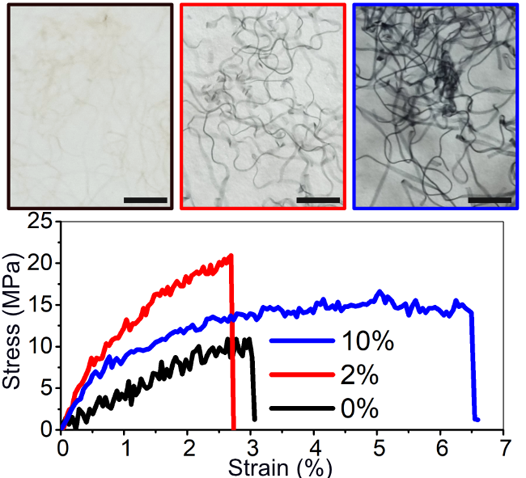Recent News
- 2023 -
Food amyloid do not cross-seed amyloid beta
We and many others are exploring amyloid-like nanofibrils in efforts to create new materials or new food. These fibrils can be produced from a variety of different resources, including many proteins that are part of common foodstuff. The structural similarity between the food-derived fibrils and those associated with disease amyloid is an obvious concern - could they trigger the aggregation of the critical disease associated proteins, such as amyloid beta that is involved Alzheimer's disease? Fortunately, the answer to that questions seems to be'no' as we now can show that none of the 16 tested food amyloid accelerate amyloid beta aggregation. The paper was just published in Nature Scientific Reports. The results are also highlighted in KTH News (only in Swedish).

- 2022 -
Improved manufacturing process for whey protein fibers
We have taken the flow-assisted assembly of fibers from milk proteins one step further. In our recent study we use a sustainable and non-toxic crosslinker to achieve improved mechanical properties of microfibers assembled from whey protein nanofibrils. The approach allows us to disconnect the fibril morphologies and the inter-fibril interactions in the flow-assisted assembly process and reveal important components of the structure-function relationship. We find that variations in fibril nanostructure have more noticeable effects on the structural and mechanical properties of the final fiber than previously expected. The study was published in ACS Nano.

How protein nanostructure deterimes macroscopic apperance of materials
The nanoscle structure of protein nanofibrils determines the structural features of the micro- and macroscale of protein films. The structural differences can be seen by the naked eye. The origin of the distict structural features sems to be a process that involves restriuctd capillary flows and local gel formation. We also demonstate two ways by which the structure can be controlled without losing the chemical functionality of the protein nanofibrils. The study was just published in Nanoscale.

- 2021 -
Protein foams with exceptional stability
Protein nanofibrils from whey can be used to produce foams (aerogels). These foams have the facinating behavior of becoming stronger and stronger during incubation at temperatures that melt many other polymers. The foams also remain intact in harsh environments such as DTT+SDS+ 6M urea and in hot oil or diesel. Maybe proteins can be the future material of choice for high temperature applicatins? The works was done in collaboration with Mikael Hedenqvist's group and is published in Advances Sustainable Systems.

- 2020 -
Characterization of amyloid-β multiprotein aggregates using FACS
Amyloid fibrils of amyloid-β attracts a "corona" of other proteins and become multi-protein particles in CSF environment. In our latest publication we use flow cytometry to isolate these amyloid particles and analyse their compositions. Published in ACS Chemical Neuroscience.

Amyloid-like fibrils from potato protein
Potato proteins can form amyloid-like fibrils. This is shown in our latest publication in ACS Sustainable Chemistry & Engineering.

- 2017 -
Second Protein Materials workshop.
The second workshop of the Swedish Protein materials network was organized in March 2017. More information here!
- 2015 -
Workshop on protein-based materials
In 2015 we organized a one day workshop on protein-based materials:
Invitation_Workshop_27Oct_2.pdf
Paper highlighted in Nature Chemical Biology
Our paper about binding of human proteins to amyloid-ß protofibrils has been highlighted in Nature Chemical Biology.
Read the research highlight here.
Our article can be found here.